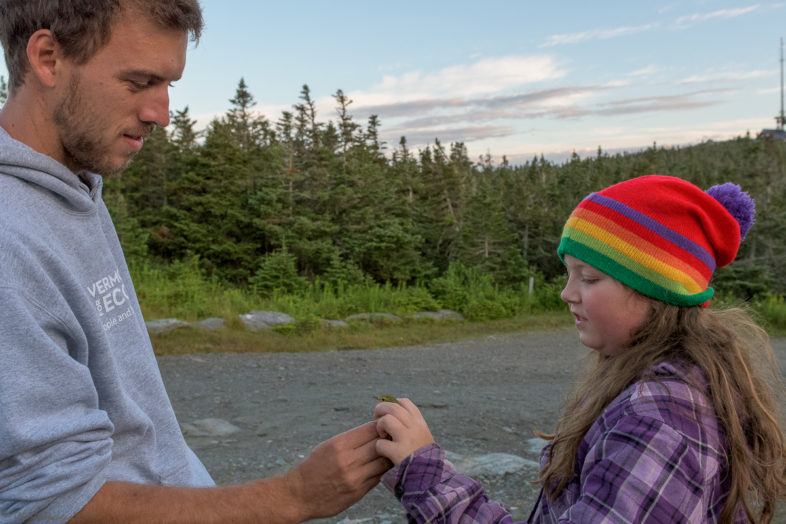
Spencer Hardy transfers a banded Blackpoll Warbler to Antonia (Toni) Howard for release. Mt. Mansfield, 14 August 2019. © Charles Gangas
VCE’s wrap-up summer banding session on Mt. Mansfield last week bore little resemblance to its predecessors, except in the ridgeline’s continued silence. Having missed two recent field visits due to weather and scheduling conflicts, we extended our 2019 season two weeks later than usual. The evening of 13 August featured idyllic weather—warm, dead calm, patchy cloud cover—and we quickly set up 25 mist nets. Not an avian peep was heard, movement seen, or capture recorded for the first 2+ hours. Our dusk run netted 8 birds—the evening’s first and only—of which 5 were juvenile Dark-eyed Juncos.
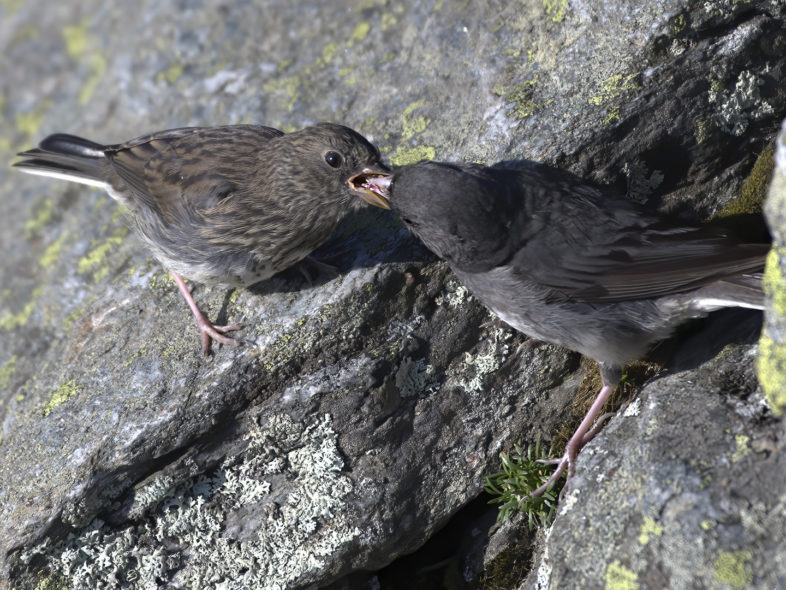
Mansfield’s most conspicuous local birds—both in and away from VCE’s nets—on 13-14 August were Dark-eyed Juncos. Here an adult male feeds a ravenous juvenile. © Michael Sargent
Hopes ran high as we arrived back on the ridgeline at the leisurely hour of 0430, having “slept in” compared to June, and reopened our nets. Again, the fir thickets lay still and silent at dawn, though a Bicknell’s Thrush or two gave perfunctory calls. We began capturing birds right off the bat, though species composition was far different from the previous two months, as dispersers from northern hardwoods made a strong showing. By morning’s end, we had netted far more non-local than local birds, including a dozen Black-throated Blue Warblers, which VCE’s previous research has shown undertake a regular and pronounced postfledging upslope dispersal into montane forests. Amazingly, we did not recapture a single individual of any species from earlier in the season, a sure sign that local adults are laying low as they molt flight feathers in preparation for southward migration.

Similarly-plumaged immature Magnolia (two upper birds) and Canada (lower photo) warblers on Mt. Mansfield, 14 August 2019. © Charles Gangas
Our two-day tally of 49 captures (2019’s biggest single catch) included:
Blue-headed Vireo — 1 hatching-year (HY) bird
Winter Wren — 2 HYs
Bicknell’s Thrush — 1 free-flying juvenile
Swainson’s Thrush — 2 new adults, including female with regressing brood patch
American Robin — 2 free-flying juveniles
Dark-eyed Junco (Slate-colored) — 13 free-flying juveniles
White-throated Sparrow — 1 adult in heavy flight feather molt
Ovenbird — 7 HYs
Black-and-white Warbler — HY male and female
Magnolia Warbler — 2 HY birds
Blackpoll Warbler — 2 HYs completing first prebasic molt
Black-throated Blue Warbler — 12 HY birds (3 males, 9 females)
Yellow-rumped Warbler (Myrtle) — 1 HY bird transitioning from juvenal to first basic plumage
Canada Warbler — 1 HY female
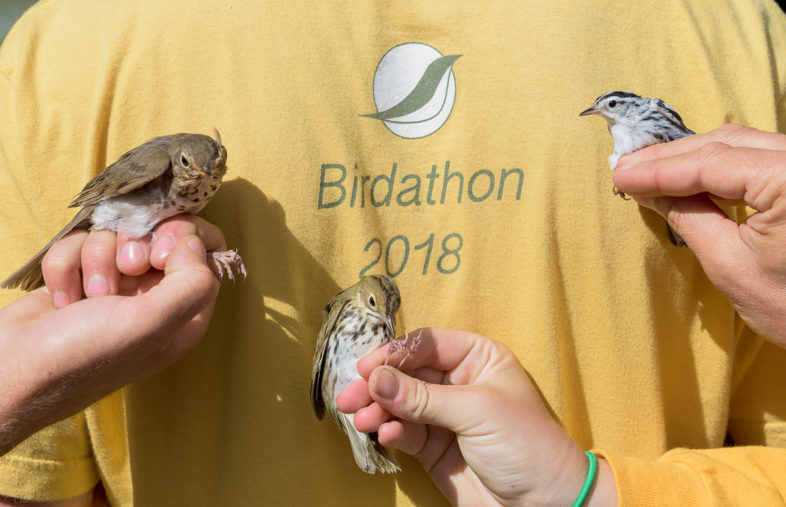
Avian advertisers for VCE: from left to right, adult Swainson’s Thrush, HY Ovenbird, HY Black-and-white Warbler. © Charles Gangas
We anticipate a final wrap-up banding session in mid-September, by which time some local breeders will have departed, while Bicknell’s Thrushes undergo their annual “resurgence” of vocal activity, just prior to heading south. Despite the migrant gems that inevitably surprise us then, it’s a bittersweet time for us banders, though we take solace knowing we’ll be back in <9 months.
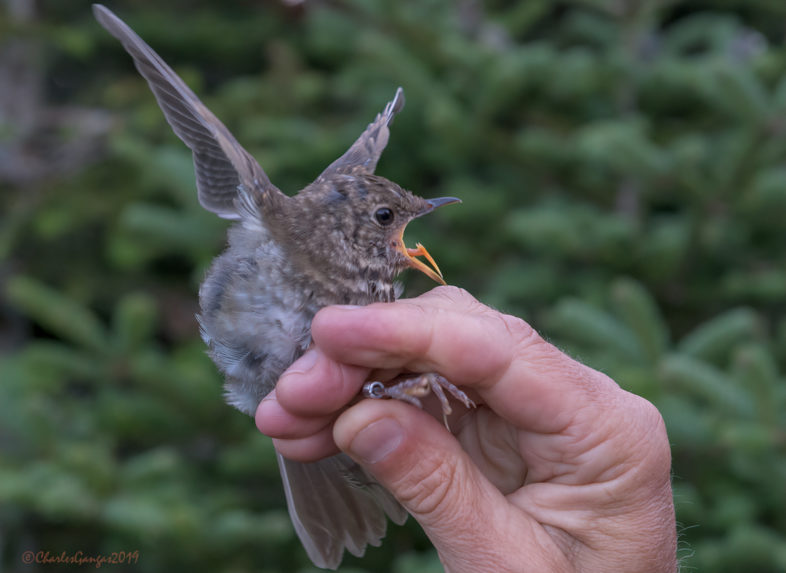
A juvenile Bicknell’s Thrush protests the notion that it may be recaptured in 2020. © Charles Gangas
As always, we welcome visitors of all ages and birding backgrounds to our long-term banding operation on Mansfield, and we look forward to seeing smiles light the faces of many next season.
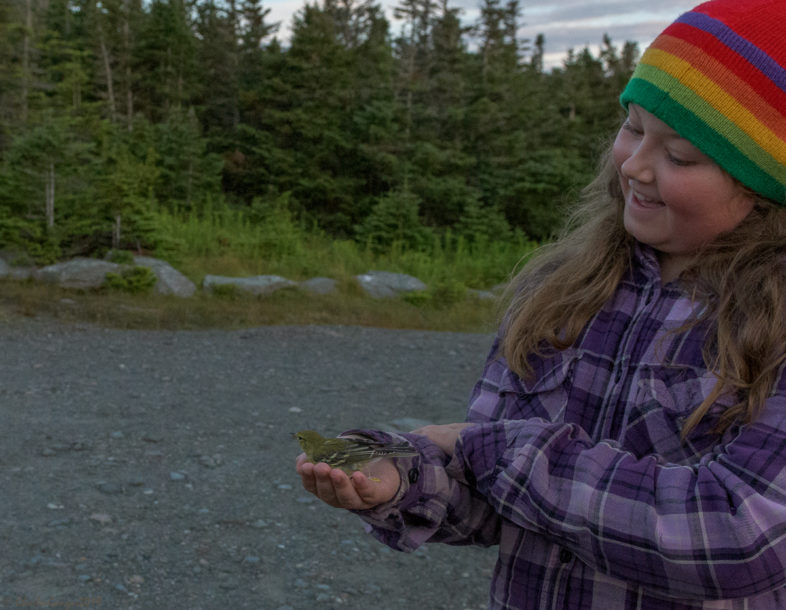
Toni Howard savors a close encounter with an immature banded Blackpoll Warbler prior to its release on Mansfield, 14 August 2019. © Charles Gangas
